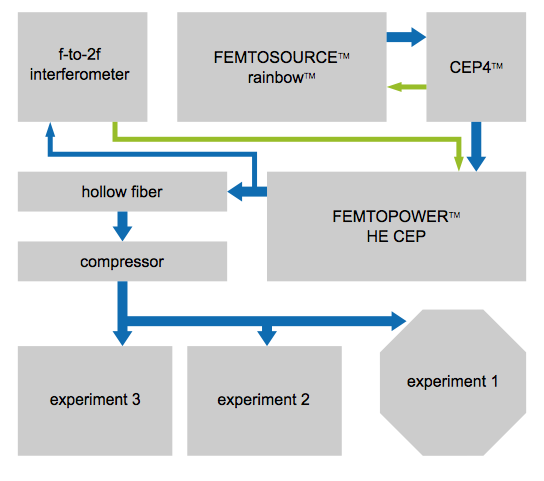The ultrashort-pulse laser PHaser
The ultrashort-pulse laser PHaser
The PHaser (Phase-stabilized Heine Laser) is our group’s laser system and is the basic tool for all our experiments. The main components have been delivered by the company Femtolasers and have been optimized for our purposes in our group.
The laser pulses are generated in an oscillator (FEMTOSOURCETM rainbowTM) which is pumped by a Nd:YAG-laser. The pulses are then temporally stretched for keeping the power sufficiently small in the subsequent FEMTOPOWERTM HE CEP amplifier, and are finally re-compressed. A that point we have laser pulses with 3.3 mJ energy and 25 fs duration which can be used in experiments in our so-called “long-pulse mode”.
For getting our light pulses even shorter, we send them through a neon-filled hollow fiber which leads to spectral broadening. After that, the pulses can be compressed to durations far below 10 fs by means of special chirped mirrors with a pulse energy of still 1 mJ. This is our „short pulse mode“ with only a few oscillations of the electromagnetic light field („few-cycle pulses“). The pulses enter the vacuum at that point and travel to the three experimental chambers where they can be used for experiments.
The laser can be used in two modi of operation:
| short pulse | long pulse | |||
| Parameters: | Pulse duration: | < 7 fs | or | 25 fs |
| Pulse energy: | 1 mJ | or | 3,3 mJ | |
| Wavelength: | 800 ± 150 nm | or | 800 ± 25 nm | |
| Repetition Rate: | 1 Hz - 1 kHz (1 to 1000 pulses per second) | |||
| or | one or several single pulses | |||
Our light pulses are CEP-stabilized as a special feature, which means that the phase between the amplitude and the oscillating field is locked and can be varied in a defined way. This stabilization ist introduced by the CEP4TM-Modue behind the oscillator. Furthermore, a piezo-crystal in the stretcher, which is controlled by the “f-to-2f interferometer“ behind the amplifier, guarantees that the whole system emits CEP-stabilized pulses.
Our light pulses‘ various parameters are characterized by special diagnostics which has been developed partly in-house, for example
- Temporal puls shape and duration: SPIDER
- Bandwidth and spectrum
- Pulse energy
- Spatial beam profile
- Contrast level, pre- and post-pulses: 3rd order autocorrelator
- Amplitude front tilt and angular chirp: SRI and inverted field autocorrelator


